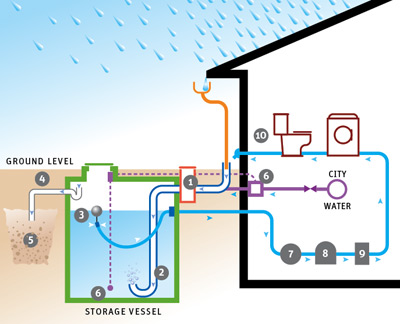Rainwater harvesting is any form of collecting rainwater from a surface. It has been used by civilizations all over the world for centuries. Traditionally rainwater harvesting has been used as a method to provide more water for irrigation purposes. Now however, many people are looking to rainwater harvesting as a great method of conservation. Across the US, cities and states are looking at building codes and water restrictions in order to update the
 m to allow rainwater harvesting. At this time though, most places in the US prohibit it (except as a farming technique) and others that allow it only permit the water to be used for non potable use (toilet flushing, irrigation, car washing...). The two most progressive cities in the US right now for this upcoming technology are Portland, OR and Austin, TX.
m to allow rainwater harvesting. At this time though, most places in the US prohibit it (except as a farming technique) and others that allow it only permit the water to be used for non potable use (toilet flushing, irrigation, car washing...). The two most progressive cities in the US right now for this upcoming technology are Portland, OR and Austin, TX.Here in the Dominican Republic I am designing a rainwater harvesting system for the Punta Cana Resort and Club. This system and report will show how much water is available to harvest, based on roof size, roof material, and average rainfall. It will also show an estimated cost for the system. In the US, there is a "return" factor based on water price and electricity that dictates whether the system will repay itself over time. Here, this resort has several wells that provide the water so they do not pay a water tariff. They will save money however, because they will use less electricity pumping water from the water treatment plant. One of the main concerns on this primarily coastal country is the limited freshwater aquifers. Especially on the coast, saltwater may infiltrate the freshwater table in a matter of years if water is not conserved. The resort is very receptive of conservation possibilities. Unfortunately, many other resorts are not so interested. Hopefully, they will soon find that preserving the environment is really preserving the toursim industry and the economy of this beautiful country.
